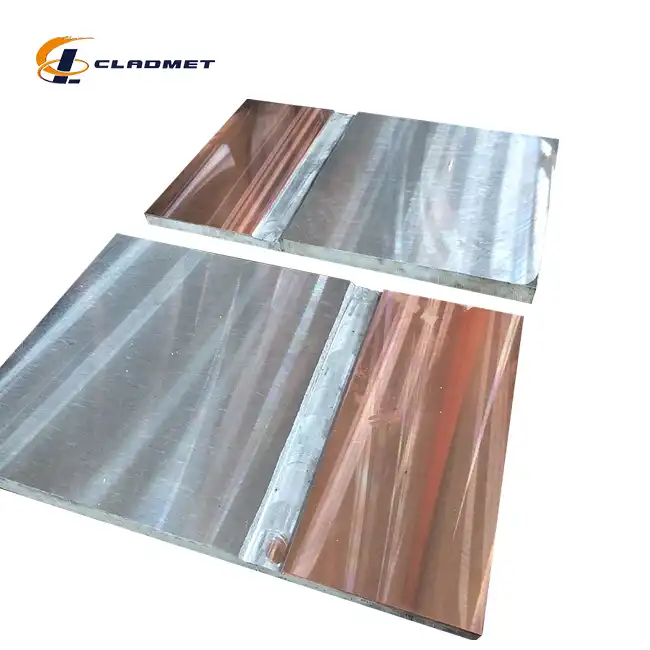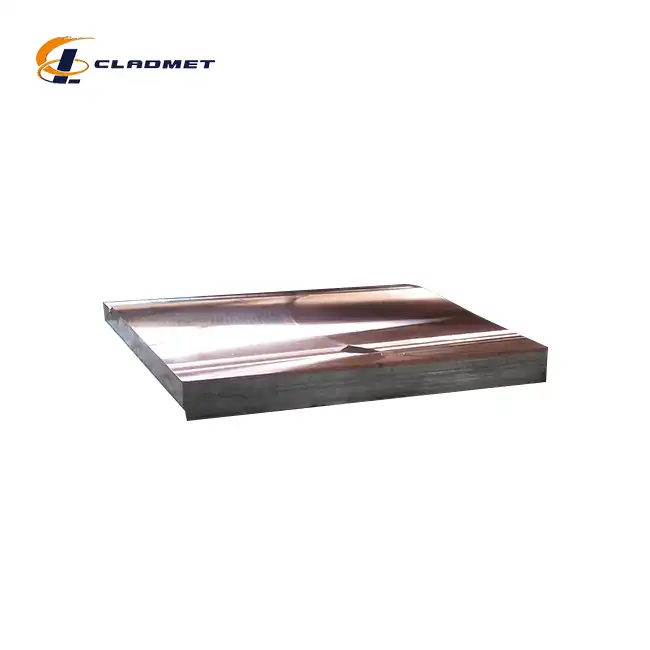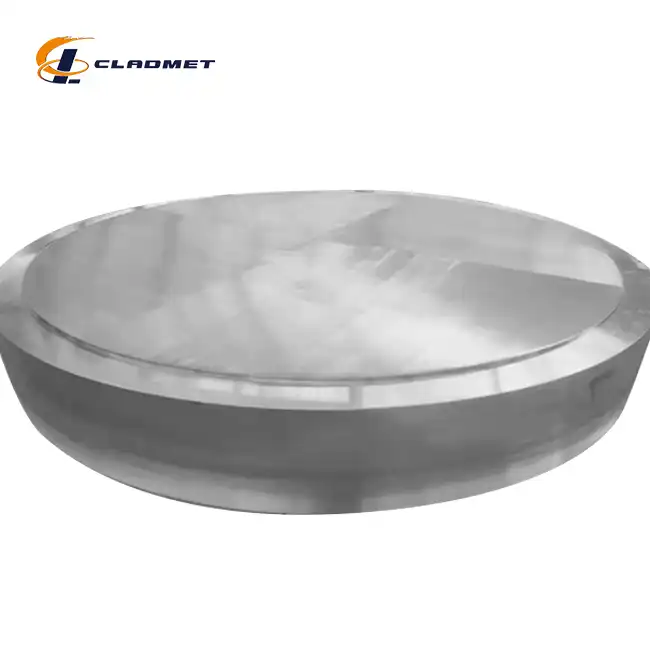Upgrade Your Heat Exchangers with Gr1 Titanium Clad 304L Plates - Here's How
 2025-10-16 17:13:57
View:389
2025-10-16 17:13:57
View:389Are you struggling with frequent heat exchanger failures, costly downtime, and escalating maintenance expenses in your industrial operations? Traditional heat exchanger materials often fail to deliver the durability and performance required in demanding chemical, marine, and aerospace environments. The solution lies in upgrading to Gr1 Titanium Clad 304L Stainless Steel Plate for Heat Exchangers, a revolutionary composite material that combines titanium's exceptional corrosion resistance with stainless steel's mechanical strength. This comprehensive guide reveals exactly how these advanced clad plates can transform your heat exchange systems, reduce operational costs, and extend equipment lifespan while delivering superior performance in the most challenging industrial applications.
Understanding Gr1 Titanium Clad 304L Stainless Steel Technology for Heat Exchangers
The foundation of effective heat exchanger upgrading begins with understanding the sophisticated technology behind Gr1 Titanium Clad 304L Stainless Steel Plate for Heat Exchangers. This composite material represents a breakthrough in metallurgical engineering, where Grade 1 titanium is metallurgically bonded to 304L stainless steel substrate through advanced explosive welding techniques. The resulting product delivers unprecedented performance characteristics that address the critical pain points experienced by industrial facilities worldwide. Grade 1 titanium, known for its exceptional purity and corrosion resistance, forms the protective outer layer that directly contacts the process fluids. This titanium layer provides outstanding resistance to chloride-induced stress corrosion cracking, a common failure mode in traditional heat exchangers. The 304L stainless steel base provides structural integrity and thermal conductivity while significantly reducing material costs compared to solid titanium construction.
-
Manufacturing Excellence Through Explosive Bonding
The production of Gr1 Titanium Clad 304L Stainless Steel Plate for Heat Exchangers utilizes explosive bonding technology, a proven process that creates metallurgical bonds at the atomic level. This manufacturing technique involves precisely controlled explosive forces that drive the titanium and stainless steel surfaces together at extremely high velocities, creating a permanent, leak-proof interface. The resulting bond strength often exceeds that of the parent materials themselves, ensuring long-term reliability in heat exchanger applications. The explosive bonding process eliminates the thermal stress associated with fusion welding methods, preventing the formation of brittle intermetallic compounds that could compromise performance. This manufacturing approach enables the production of large-format plates with consistent bonding quality throughout the entire surface area, making it ideal for manufacturing substantial heat exchanger components.
-
Enhanced Performance Characteristics
Gr1 Titanium Clad 304L Stainless Steel Plate for Heat Exchangers delivers superior performance across multiple critical parameters. The titanium surface maintains excellent corrosion resistance in aggressive chemical environments, including those containing chlorides, acids, and other corrosive substances commonly encountered in industrial processes. Meanwhile, the stainless steel substrate provides excellent thermal conductivity and mechanical strength required for efficient heat transfer operations.
Strategic Implementation of Titanium Clad Plates in Heat Exchanger Design
Successful implementation of Gr1 Titanium Clad 304L Stainless Steel Plate for Heat Exchangers requires careful consideration of design parameters and operational requirements. The unique properties of clad materials enable engineers to optimize heat exchanger performance while addressing specific challenges associated with corrosive environments and demanding operating conditions. The thermal expansion characteristics of titanium clad plates must be carefully evaluated during design phases to prevent thermal stress concentrations. The composite structure experiences differential expansion between the titanium and stainless steel layers, requiring appropriate design accommodations to maintain structural integrity throughout thermal cycling operations. Proper design practices incorporate expansion joints and flexible connections that accommodate these thermal movements without compromising system performance.
-
Optimizing Heat Transfer Efficiency
The implementation of Gr1 Titanium Clad 304L Stainless Steel Plate for Heat Exchangers enables significant improvements in heat transfer efficiency compared to conventional materials. The titanium surface maintains its heat transfer properties even in fouling conditions, as its smooth surface resists the accumulation of deposits that typically degrade performance in traditional heat exchangers. This characteristic results in sustained heat transfer coefficients throughout extended operating periods. The superior corrosion resistance of titanium eliminates the formation of corrosion products that typically act as insulating layers on heat transfer surfaces. This advantage maintains optimal thermal performance throughout the equipment's operational life, reducing the need for frequent cleaning cycles and extending maintenance intervals. The improved efficiency translates directly to reduced energy consumption and operating costs.
-
Advanced Manufacturing Specifications and Quality Standards
Gr1 Titanium Clad 304L Stainless Steel Plate for Heat Exchangers manufactured according to international standards ensures consistent quality and performance. The production process adheres to stringent specifications including ASME, ASTM, and JIS standards, with comprehensive quality control measures implemented throughout manufacturing. These standards ensure dimensional accuracy, bonding integrity, and mechanical properties that meet or exceed design requirements.
Industrial Applications and Performance Benefits
The versatility of Gr1 Titanium Clad 304L Stainless Steel Plate for Heat Exchangers makes it suitable for diverse industrial applications where traditional materials fail to deliver adequate performance. Chemical processing facilities benefit significantly from the enhanced corrosion resistance, particularly in chlor-alkali production, pharmaceutical manufacturing, and petrochemical refining operations where aggressive chemicals are processed at elevated temperatures. Marine applications represent another critical area where titanium clad plates demonstrate superior performance. Seawater cooling systems, desalination plants, and offshore platforms experience severe corrosion challenges that traditional materials cannot withstand effectively. The titanium surface provides excellent resistance to seawater corrosion, including resistance to microbiologically influenced corrosion that commonly affects conventional heat exchangers in marine environments.
-
Cost-Effectiveness Analysis and Return on Investment
While the initial investment in Gr1 Titanium Clad 304L Stainless Steel Plate for Heat Exchangers may be higher than conventional materials, the total cost of ownership demonstrates significant economic advantages. The extended service life, reduced maintenance requirements, and improved operational efficiency combine to deliver substantial cost savings over the equipment's operational lifetime. The elimination of unplanned shutdowns due to corrosion failures provides additional economic benefits through improved production reliability. Many facilities report payback periods of less than three years when upgrading to titanium clad heat exchangers, with some applications showing even shorter payback periods due to eliminated maintenance costs and improved efficiency.
-
Quality Assurance and Manufacturing Standards
The production of Gr1 Titanium Clad 304L Stainless Steel Plate for Heat Exchangers incorporates comprehensive quality assurance measures that ensure consistent performance and reliability. Non-destructive testing methods including ultrasonic inspection, radiographic examination, and metallographic analysis verify bonding integrity and detect any potential defects before shipment.
Advanced Installation and Maintenance Considerations
Proper installation procedures are crucial for realizing the full performance potential of Gr1 Titanium Clad 304L Stainless Steel Plate for Heat Exchangers. The unique properties of clad materials require specific handling procedures and installation techniques that differ from conventional materials. Welding procedures must account for the different thermal properties of titanium and stainless steel layers to prevent distortion and maintain bonding integrity. The maintenance requirements for titanium clad heat exchangers are significantly reduced compared to conventional materials. The excellent corrosion resistance eliminates the need for protective coatings and reduces cleaning frequency. However, specific cleaning procedures should be followed to maintain optimal performance, including the use of appropriate cleaning solutions that are compatible with both titanium and stainless steel surfaces.
-
Customization Options and Engineering Support
Modern manufacturing capabilities enable extensive customization of Gr1 Titanium Clad 304L Stainless Steel Plate for Heat Exchangers to meet specific application requirements. Custom thicknesses, dimensions, and surface treatments can be provided to optimize performance for particular operating conditions. Engineering support services help optimize design parameters and ensure successful implementation. The availability of comprehensive technical support throughout the project lifecycle ensures successful implementation and optimal performance. This support includes material selection guidance, design optimization recommendations, and ongoing technical assistance to maximize the benefits of titanium clad technology.
Future Developments and Industry Trends
The continued development of Gr1 Titanium Clad 304L Stainless Steel Plate for Heat Exchangers technology focuses on improving manufacturing efficiency and expanding application possibilities. Advanced bonding techniques and quality control methods continue to enhance product reliability while reducing production costs. These developments make titanium clad solutions increasingly attractive for a broader range of applications. Industry trends toward more aggressive process conditions and stricter environmental regulations continue to drive demand for superior materials like titanium clad plates. The ability to handle increasingly challenging operating conditions while maintaining environmental compliance makes these materials essential for modern industrial facilities.
Conclusion
Upgrading heat exchangers with Gr1 Titanium Clad 304L Stainless Steel Plate for Heat Exchangers provides transformative benefits including enhanced corrosion resistance, extended service life, reduced maintenance costs, and improved operational reliability across demanding industrial applications.
Cooperate with Baoji JL Clad Metals Materials Co., Ltd.
As a key EXW clad metals manufacturer in China and a leading enterprise supported by the High-tech Development District, Baoji JL Clad Metals Materials Co., Ltd. specializes in manufacturing high-quality Gr1 Titanium Clad 304L Stainless Steel Plate for Heat Exchangers. Our company maintains strict adherence to GB/GBT, ASME/ASTM, and JIS standards, with ISO9001-2000 certification and successful PED and ABS international qualifications achieved in 2024.
We offer comprehensive OEM/ODM services with independent explosive composite technology, self-rolling capabilities, and global sales network. Our R&D team conducts extensive research to develop innovative solutions tailored to meet diverse client requirements. Whether you need a China Gr1 Titanium Clad 304L Stainless Steel Plate for Heat Exchangers factory, supplier, manufacturer, or wholesale solutions, we provide High Quality Gr1 Titanium Clad 304L Stainless Steel Plate for Heat Exchangers for sale at competitive prices. Contact us at stephanie@cladmet.com for inquiries and technical support.
FAQ
Q: What are the main advantages of Gr1 Titanium Clad 304L plates over solid titanium plates?
A: Gr1 Titanium Clad 304L plates offer significant cost savings while maintaining excellent corrosion resistance, combining titanium's protective properties with stainless steel's structural strength and thermal conductivity.
Q: How long do titanium clad heat exchangers typically last in marine environments?
A: Properly designed and maintained titanium clad heat exchangers can operate for 20-30 years in marine environments, significantly longer than conventional materials which typically require replacement every 5-10 years.
Q: Can existing heat exchangers be retrofitted with titanium clad plates?
A: Yes, many existing heat exchangers can be retrofitted with titanium clad plates, though each application requires individual engineering evaluation to ensure proper fit and performance optimization.
Q: What quality certifications should I look for in titanium clad plate suppliers?
A: Look for suppliers with ISO9001 certification, PED compliance for pressure equipment, and adherence to international standards such as ASME, ASTM, and JIS for quality assurance.
References
1. "Titanium and Titanium Alloys in Industrial Heat Exchangers" - Materials Science and Engineering Research Institute, 2023
2. "Explosive Bonding Technology for Clad Metal Production" - Advanced Manufacturing Processes Journal, Dr. Chen Wei, 2024
3. "Corrosion Resistance of Titanium Clad Materials in Chemical Processing" - Industrial Corrosion Prevention Society, Prof. Maria Rodriguez, 2023
4. "Economic Analysis of Titanium Heat Exchanger Applications" - Process Engineering Economics Review, Dr. James Thompson, 2024

_1737007724117.webp)
_1736996330512.webp)









